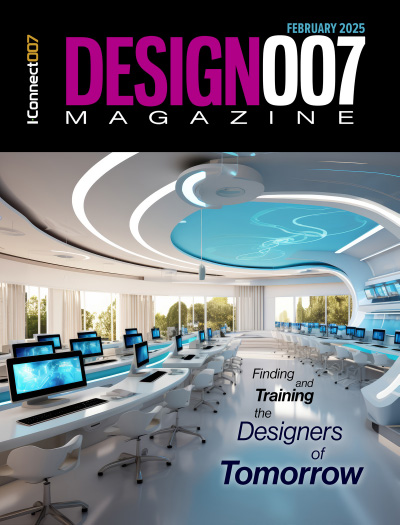-

- News
- Books
Featured Books
- design007 Magazine
Latest Issues
Current Issue
Designing Through the Noise
Our experts discuss the constantly evolving world of RF design, including the many tradeoffs, material considerations, and design tips and techniques that designers and design engineers need to know to succeed in this high-frequency realm.

Learning to Speak ‘Fab’
Our expert contributors clear up many of the miscommunication problems between PCB designers and their fab and assembly stakeholders. As you will see, a little extra planning early in the design cycle can go a long way toward maintaining open lines of communication with the fab and assembly folks.

Training New Designers
Where will we find the next generation of PCB designers and design engineers? Once we locate them, how will we train and educate them? What will PCB designers of the future need to master to deal with tomorrow’s technology?
- Articles
- Columns
Search Console
- Links
- Media kit
||| MENU - design007 Magazine
Book Excerpt: Producing the Perfect Data Package, Part 2
June 18, 2020 | I-Connect007 Editorial TeamEstimated reading time: 2 minutes
The following is an excerpt from Chapter 2 of Mark Thompson's I-Connect007 eBook The Printed Circuit Designer’s Guide to... Producing the Perfect Data Package. Mark is in engineering support at Prototron Circuits and a Design007 Magazine columnist.
Chapter 2
Contents of the PCB Output Package
This chapter will cover the five “must-haves” for an output package—drawings and README files, image data, NC Drill files, IPC netlists, and assembly array drawings—and conclude with a brief note on manufacturability data edits.
A. DRAWINGS AND README FILES
Since one of the first things a salesperson will do to create a quote is review your drawings and README files, let’s start with what should be included on a fabrication drawing. README files are typically simple text documents (Word or Notepad) that describe the files and provide information to be conveyed to the fabricator that may not be on the drawing, such as known netlist shorts or opens, specifics about controlled impedances, etc. Drawings are typically exported as a PDF, DXF, or Gerber image file.
Note: Any discrepancies or conflicts between drawings or files will require clarification between the salesperson and designer, which will delay the quote process. A frequent issue is inaccurate, confusing, or conflicting notes on drawings. A quick cursory look at all your output documents is advised to make sure you have no troublesome notes.
Drawings should include the following nine fabrication specifications at a minimum:
A1. Board outline with dimensions and tolerances
Many output packages come in with files that use different origins (i.e., not all files are aligned as they should be). This creates issues with layer-to-layer alignment, as well as X and Y board dimensional requirements and tolerances associated with those dimensions. It is always good practice to have a dimensioned hole as the X0Y0 origin. This allows the fabricator to align the NC Drill file with the image data. Ideally, the board outline should also exist on the image data. If an assembly array drawing is being provided for specific panelization needs, make sure there are no conflicts between the board outline in the image data and the array image data, such as showing chamfered corners on the image data but radii on the array drawing.
To download your copy of Mark Thompson’s eBook The Printed Circuit Designer’s Guide to... Producing the Perfect Data Package, click here.
To visit the I-Connect007 library and check out the entire lineup of free eBooks, click here.
Suggested Items
Nolan's Notes: The Next Killer App in Component Manufacturing
05/02/2025 | Nolan Johnson -- Column: Nolan's NotesFor quite a while, I’ve been wondering what the next “killer app” will be in electronics manufacturing and why it has been so long since the last disruptive change in EMS. I believe the answer lies in artificial intelligence, which has exploded as the next disruptor.
IPC Excellence in Education Award: Zenaida Valianu
05/01/2025 | Nolan Johnson, I-Connect007Zenaida Valianu is the training manager at IPC who brings more than 25 years of expertise in standards and training development to her role. She has revolutionized IPC certification training programs by significantly enhancing their content with comprehensive curricula and engaging materials. She has also been instrumental in developing essential workforce training courses and contributing to various other initiatives.
A Visit With ‘Flexperts’ Mark Finstad and Nick Koop
05/01/2025 | Joe Fjelstad, Verdant ElectronicsAt IPC APEX EXPO 2025, I chatted with seasoned flex experts Mark Finstad and Nick Koop about "Flexperts" and their roles as leading educators and in the realm of standards development for this increasingly indispensable electronic interconnection technology. They have been teaching about lessons learned and how to successfully navigate the “seas” of flexible circuits to help their students avoid the hazards that have taken down many of their predecessors in the past.
Real Time with... IPC APEX EXPO 2025: Improving the Electronics Industry With Advanced Packaging
04/30/2025 | Real Time with...IPC APEX EXPODevan Iyer, the Chief Strategist for Advanced Packaging at IPC, shares insights from his recent presentation at the EMS Leadership Summit. The discussion covers the importance of understanding market segments in IoT, power electronics, and high-performance computing. EMS companies are encouraged to specialize, invest wisely, and collaborate to meet customer needs.
Real Time with... IPC APEX EXPO 2025: The Role of AI in Advanced Packaging
04/30/2025 | Real Time with...IPC APEX EXPOIn a follow-up to his keynote, Dr. Ahmad Bahai, discusses the critical intersection of advanced packaging, computing, and AI in semiconductor innovation with Nolan Johnson and Devan Iyer. He emphasizes the need for new approaches to handle the data economy and highlights AI's role in optimizing electronics manufacturing. The conversation covers challenges in power and thermal management, the impact of AI on EDA tools, and bio-inspired innovations. Predictions about future trends point towards increased efficiency in design and manufacturing.


